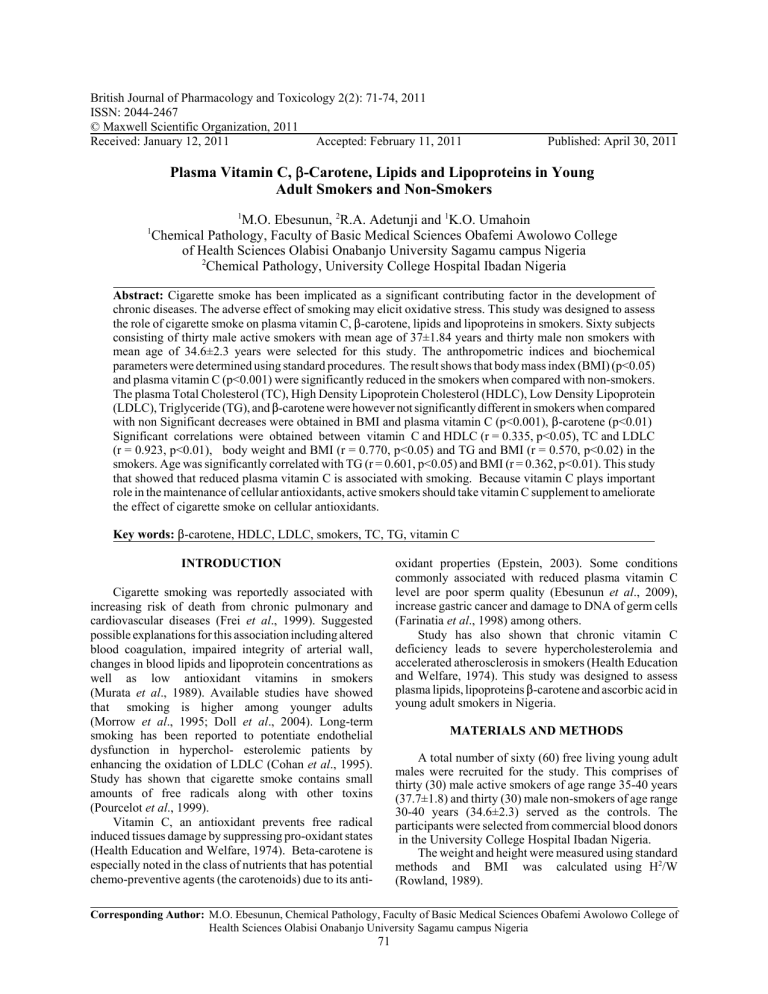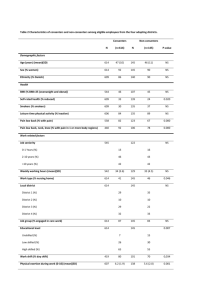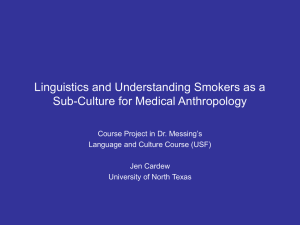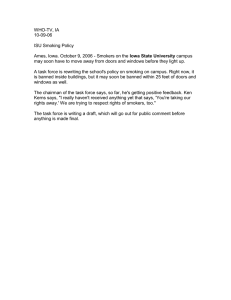British Journal of Pharmacology and Toxicology 2(2): 71-74, 2011 ISSN: 2044-2467

British Journal of Pharmacology and Toxicology 2(2): 71-74, 2011
ISSN: 2044-2467
© Maxwell Scientific Organization, 2011
Received: January 12, 2011 Accepted: February 11, 2011 Published: April 30, 2011
Plasma Vitamin C,
$
-Carotene, Lipids and Lipoproteins in Young
Adult Smokers and Non-Smokers
1
M.O. Ebesunun,
2
R.A. Adetunji and
1
K.O. Umahoin
1
Chemical Pathology, Faculty of Basic Medical Sciences Obafemi Awolowo College of Health Sciences Olabisi Onabanjo University Sagamu campus Nigeria
2
Chemical Pathology, University College Hospital Ibadan Nigeria
Abstract: Cigarette smoke has been implicated as a significant contributing factor in the development of chronic diseases. The adverse effect of smoking may elicit oxidative stress. This study was designed to assess the role of cigarette smoke on plasma vitamin C,
$
-carotene, lipids and lipoproteins in smokers. Sixty subjects consisting of thirty male active smokers with mean age of 37±1.84 years and thirty male non smokers with mean age of 34.6±2.3 years were selected for this study. The anthropometric indices and biochemical parameters were determined using standard procedures. The result shows that body mass index (BMI) (p<0.05) and plasma vitamin C (p<0.001) were significantly reduced in the smokers when compared with non-smokers.
The plasma Total Cholesterol (TC), High Density Lipoprotein Cholesterol (HDLC), Low Density Lipoprotein
(LDLC), Triglyceride (TG), and
$
-carotene were however not significantly different in smokers when compared with non Significant decreases were obtained in BMI and plasma vitamin C (p<0.001),
$
-carotene (p<0.01)
Significant correlations were obtained between vitamin C and HDLC (r = 0.335, p<0.05), TC and LDLC
(r = 0.923, p<0.01), body weight and BMI (r = 0.770, p<0.05) and TG and BMI (r = 0.570, p<0.02) in the smokers. Age was significantly correlated with TG (r = 0.601, p<0.05) and BMI (r = 0.362, p<0.01). This study that showed that reduced plasma vitamin C is associated with smoking. Because vitamin C plays important role in the maintenance of cellular antioxidants, active smokers should take vitamin C supplement to ameliorate the effect of cigarette smoke on cellular antioxidants.
Key words:
$
-carotene, HDLC, LDLC, smokers, TC, TG, vitamin C
INTRODUCTION
Cigarette smoking was reportedly associated with increasing risk of death from chronic pulmonary and cardiovascular diseases (Frei
(Morrow et al ., 1995; Doll et al et al
., 1999). Suggested possible explanations for this association including altered blood coagulation, impaired integrity of arterial wall, changes in blood lipids and lipoprotein concentrations as well as low antioxidant vitamins in smokers
(Murata et al ., 1989). Available studies have showed that smoking is higher among younger adults
., 2004). Long-term smoking has been reported to potentiate endothelial dysfunction in hyperchol- esterolemic patients by enhancing the oxidation of LDLC (Cohan et al ., 1995).
Study has shown that cigarette smoke contains small amounts of free radicals along with other toxins
(Pourcelot et al ., 1999).
Vitamin C, an antioxidant prevents free radical induced tissues damage by suppressing pro-oxidant states
(Health Education and Welfare, 1974). Beta-carotene is especially noted in the class of nutrients that has potential chemo-preventive agents (the carotenoids) due to its antioxidant properties (Epstein, 2003). Some conditions commonly associated with reduced plasma vitamin C level are poor sperm quality (Ebesunun et al ., 2009), increase gastric cancer and damage to DNA of germ cells
(Farinatia et al ., 1998) among others.
Study has also shown that chronic vitamin C deficiency leads to severe hypercholesterolemia and accelerated atherosclerosis in smokers (Health Education and Welfare, 1974). This study was designed to assess plasma lipids, lipoproteins
$
-carotene and ascorbic acid in young adult smokers in Nigeria.
MATERIALS AND METHODS
A total number of sixty (60) free living young adult males were recruited for the study. This comprises of thirty (30) male active smokers of age range 35-40 years
(37.7±1.8) and thirty (30) male non-smokers of age range
30-40 years (34.6±2.3) served as the controls. The participants were selected from commercial blood donors
in the University College Hospital Ibadan Nigeria.
The weight and height were measured using standard methods and BMI was calculated using H 2
(Rowland, 1989).
/W
Corresponding Author: M.O. Ebesunun, Chemical Pathology, Faculty of Basic Medical Sciences Obafemi Awolowo College of
Health Sciences Olabisi Onabanjo University Sagamu campus Nigeria
71
Br. J. Pharmacol. Toxicol., 2(2): 71-74, 2011
Table 1: Physical and biochemical parameters in smokers and non-smokers (Mean±S.E)
Variables
Age (yrs)
Weight (kg)
BMI (kg/m
2
)
TC (mg/dl)
HDLC (mg/dL)
LDLC (mg/dL)
TG (mg/dL)
Vitamin C (mg/dL)
$
-carotene (µg/dL)
NS: not significant
SmokersN = 30
37.7±1.8
61.4±1.7
21.0±0.5
153±9
59±3
89±9
94±0.06
0. 86±0.05
2.69±0.17
Non-smokers N = 30
34.6±2.3
64.4±1.8
23±0.8
136±7
52±3
74±7
86±0.05
1.16±0.05
3.16±0.32
Table 2: Physical and biochemical parameters in smokers and non-smokers aged <30 years (Mean±S.D)
Variables Smokers N = 30 Non-smokers N = 30 t-value
Weight (kg)
BMI (kg/m
2
)
TC (mg/dL)
HDL-C (mg/dL)
LDL-C (mg/dL)
TG (mg/dL)
Vitamin C (mg/dL)
$
-carotene (µg/dL)
57±9
22±4
147±65
64+24
70±39
67±44
0.66±0.6
3.57±1.5
62±9
21±2
126±29
54±15
62±28
59±20
1.12±0.3
2.52±0.9
1.300
0.910
0.950
1.940
0.437
0.509
2.311
1.702
t-value
1.061
1.235
2.001
1.587
1.709
1.348
1.086
3.962
1.302
Blood sample collection: Overnight fasting (10-14 h) venous blood samples were collected from the antecubital vein of all the subjects by standard venipuncture technique into ethylene diamine tetra-acetic acid (EDTA) bottles and immediately placed in a dark wrapper to prevent oxidation of vitamin C and
$
-carotene. The samples were centrifuged at 3000 rpm for 5 min and the plasma were aspirated into a clean vial and stored at -4ºC until analyzed.
Analytical procedures: Analysis of vitamin C (Ascorbic acid) was based on the method postulated by
Kyaw (1977). This is based on the principle of the formation of a light-blue supernatant when ascorbic acid reacts with sodium tungstate in an alkaline solution; the intensity of the colour produced is proportional to the concentration of ascorbic acid in the plasma.
Analysis of
$
-carotene was based on Neeld and
Pearson (1942) in which trifluoroacetic acid reacts with the conjugated bond system of vitamin A to form a faint blue, short-lived compound. The TC was estimated using the enzymatic method of Allain et al . (1974) while TG analyzed based on the modified enzymatic method of
Bucolo and David (1973). The HDLC was determined after precipitating with heavy metal of MgCL-sodium
Tungstate solution to remove other lipoproteins fractions.
The supernant was assayed for HDLC using the same method for TC. monitored by including commercial quality control samples within each batch of test assay.
Statistical analysis: were
Accuracy and precision of biochemical tests were
All results were subjected to statistical analysis using SPSS version 11.0.
The results expressed as mean ±SE. Student t-test for parametric p-value
NS
0.05
NS
NS
NS
NS
NS
0.01
NS p-value
NS
NS
NS
NS
NS
NS
0.03
NS data was used to compare groups. Pearson correlation coefficient was used to establish associations between variables. Results were regarded as significant at p<0.05.
RESULTS
Table 1 shows the mean±standard error of all the physical and biochemical parameters in active smokers and non-smokers. The mean value of BMI (21±0.5 kg/m 2 ) in smokers was statistically decreased when compared with the corresponding mean value in the non-smokers
(23±0.8 kg/m 2 ) (p<0.05) while the mean value of
0.86±0.06 mg/dL of plasma vitamin C was also significantly decreased in the smokers compared with the corresponding value of 1.16+0.05 mg/dL in the nonsmokers (p<0.001). The increases in the other parameters were not significant.
Table 2 shows the physical and biochemical parameters in smokers and non-smokers of <30 years of age. The plasma vitamin C level was significantly reduced in the smokers (p<0.03) when compared with the corresponding values in the non-smokers of the same age.
Although there were decreases and increases in mean body weight, BMI, TC TG, LDLC, and
$
-carotene, these changes were not statistically significant when compared with the corresponding value in the non-smokers of similar age.
Table 3 shows the physical and biochemical parameters in smokers and non-smokers of >30 years of age. Plasma vitamin C (p<0.001) and
$
-carotene (p<0.01) showed significant reductions when compared with the corresponding non-smokers of the same age. No significant changes were obtained in the other parameters.
Table 4 shows the correlation coefficient of all parameters in smokers. Plasma vitamin C was positively
72
Br. J. Pharmacol. Toxicol., 2(2): 71-74, 2011
Table 3: Physical and biochemical parameters in smokers and non-smokers aged >30 years (Mean±S.D)
Variables Smokers N = 30 Non-smokers N = 30 t-value
Weight (kg)
BMI (kg/m 2 )
TC (mg/dL)
HDL-C (mg/dL)
62±9
21±3
154±49
59±17
68±12
25±5
147±35
49±15
1.640
3.661
0.450
1.730
LDL-C (mg/dL)
TG (mg/dL)
Vitamin C (mg/dL)
$
-carotene (µg/dL)
NS: not significant
91±49
97±66
0.88±0.28
2.59±0.86
86±42
99±52
1.21±0.27
3.90±2.17
0.273
0.151
3.518
2.739
Table 4: Correlation coefficient of physical and biochemical parameters in smokers
Vit C
$
–carotene TC HDLC
Variables (mg/dL) (µg/dL) (mg/dL) (mg/dL)
Age(years)
Vit 0.375*
C(mg/dL)
$
–carotene
(µg/dL)
TC(mg/dL)
HDLC 0.375*
(mg/dL)
TG(mg/dL)
LDLC(mg/d)
Weight(Kg)
BMI(kg/M
2
)
0.923**
0.412*
0.393*
*: Significant at 0.05 level; **: Significant at 0.01 level
0.085*
TG
(mg/dL)
0.382*
0.362*
LDLC
(mg/dL)
0.923** significantly correlated with plasma HDLC (r = 0.400, p<0.05) while plasma TC was positively correlated with plasma LDLC (r = 0.894, p<0.01), weight and BMI
(r = 0.770, p<0.05) respectively in the smokers. There was also significant correlation between plasma TG and
BMI (r = 0.570, p<0.01) in all the smokers.
DISCUSSION
This study demonstrated a marked decrease in plasma vitamin C in smokers. A number of studies have indicated reduced plasma vitamin C levels in smokers (Pelletier,
1970; Health Education and Welfare, 1974).The presence of injurious substances such as nicotine, carbon monoxide, carbon particles, acetaldehyde and nitrogen dioxide in cigarette smoke have been implicated in reduced bioavailability of vitamin C (Pelletier, 1970).
The plasma
$
-carotene was not significantly altered in all the smokers, interestingly however, there was decreased plasma
$
-carotene in the age group >30 years, and whether differences in age are important contributing variable in this regard remains uncertain. There is the possibility that increasing free radicals in cigarette smoke may considerably decrease the bioavailability of vitamin
C and
$
-carotene as antioxidant nutrients with increasing years of smoking. Whether this increased is related to duration of smoke could not be ascertained from this study. The reduced plasma vitamin C concentration in smokers in the present study suggests that these individuals may be at the risk of developing chronic obstructive pulmonary disease. A positive correlation of
BMI and weight in smokers further support this possibility.
Weight
(Kg)
0.412*
0.847** p-value
NS
0.001
NS
NS
NS
NS
0.001
0.01
BMI
(kg/m 2 )
0.601**
0.393*
0.362*
0.847**
Plasma
$
carotene is especially noted among the class of nutrients that is regarded as potential chemo preventive agents due to its antioxidant properties (Epstein, 2003).
Knekt et al . (1994) had earlier reported that serum concentration of vitamin C and
$
-carotene appears to play some important roles in the prevention of pulmonary damage initiated by oxidants. These two antioxidants as evident from epidemiological study are required in increased amount by smokers. (Aderson et al ., 1991). The smokers in this study appear to be at risk of these oxidative damages associated with smoking, even more at risk are age group >30 years who showed marked reduction in plasma vitamin C.
There is accumulated evidence in support of a strong association between ischemic heart disease and hypercholesterolemia (Krichevsky et al ., 1995). Although the increased in the mean plasma LDLC among smokers in this study was not statistically significant, there is the likelihood that these smokers may shift toward risk of developing atherosclerosis if the smoking habit is not controlled. Increasing evidence has it that the high risk of
Coronary Heart Disease (CHD) in smokers is medicated through increased plasma LDLC (Scott, 1995). Inhaled cigarette smoke enhances lipid peroxidation and this may lead to damage of the endothelium (Frei et al ., 1991). The positive correlation between TC and LDLC indicates that increase in TC leads to corresponding increase in LDLC thus subjecting the smokers to possibly premature CVD risk. An earlier report (Jack, 1995) showed elevated plasma HDLC in smokers contrary to our finding which showed reduced mean HDLC.
Elevated plasma triglyceride was obtained in our smokers. Elevated plasma TG has been weakly
73
association with CHD as an independent risk factor
(Grundy and Vega 1992). While the plasma vitamin C and
$
-carotene varied with age in the smokers of this study is largely unknown. However, it could be speculated that this age group may not have paid attention to healthy eating vis a vis balance diet. Thus the likelihood to develop atherosclerosis vascular disease is high particularly with cigarette smoking.
CONCLUSION
The low plasma vitamin C in smokers in the present study is an indication that smokers are most liable to develop chronic diseases associated with reduced antioxidant nutrients. Dietary supplementation of vitamin
C in smokers will reduce the risk of developing early atherosclerotic heart disease. Further study will be required on larger number of samples.
ACKNOWLEDGMENT
We wish to acknowledge the blood donor staff of the
Haematology department for their co-operation in the collection of the samples.
REFERENCES
Aderson, J.W., R. Swan, F.C. Fammy, W.O. Dedra and
O. Peter, 1991. Bakery products lower serum cholesterol concentration. Am. J. Clin. Nutr., 54:
836-840.
Allain, C.A., L.S. Pooni and C.A. Cha, 1974. Enzymatic determination of total serum cholesterol. Clin.
Chem., 20:470-475.
Buccolo, G. and H. David, 1973. Quantitative determination of serum triglycerides by the use of enzymes. Clin. Chem .
, 19: 476-482.
Cohan, R., 1995. The role of Nitric oxide and other endothelium derived vasoactive substance in vascular disease. Prog. Cardio Dis., 38: 105-128.
Doll, R., R. Peto, J. Boreham and I. Sutherland, 2004.
Mortality in relation to smoking: 50 years' observations on male British doctors. BMJ, 328:
1519.
Ebesunun, M.O., O.B. Shittu, O. Famooto,
E.O. Agbedana and J.I. Anector, 2009. Ascorbic acid supplementation and spermatogenesis in Nigerian men. Open Clin. Chem. J., 2: 35-45.
Epstein, K.R., 2003. The role of carotenoids on the risk of lung cancer. Semin Oncol., 30(1): 86-93.
Farinatia, F., R. Cardina, P. Deganc, M. Rugged, F. Di
Marioa, P. Bonvicinib and R. Naccaratoa, 1998 .
Oxidative DNA damage accumulation in gastric carcinogenesis. Gut, 42: 351-356.
Br. J. Pharmacol. Toxicol., 2(2): 71-74, 2011
Frei, B., 1991. Ascorbic acid protect 5 lipid in human plasma and LDL against oxidative damage. Am. J.
Clin. Nutr., 54(Suppl): 11135-11185.
Grundy, S.M. and G.L. Vega, 1992. Two different views of the relationship of hypertriglyceridemia to coronary heart disease: Implication for treatment
(Review). Arch. Int. Med., 152: 28-34.
Health Education and Welfare (HEW) Dep., 1974. The
Health Consequences of Smoking. U.S Govt.
Printing Office. Wash. D.C., pp: 17.
Jack, P.S., 1995. Natural History and risk factors for early human artherogenesis. Clin. Chem., 41(1): 134-138.
Knekt, P., A. Reinamem, R. Jarvinen, R. Seppanen,
M. Heliovava and A. Aroma, 1994. Antioxidant vitamin intake and coronary mortality in a longitudinal population study. Am. J. Epidemics,
139: 1180-1189.
Krichevsky, S.B., T. Shimakawa, G.S. Tell, B. Dennis,
M. Carpenter, J.H. Eckfeldt, H. Peacher-Ryan and
G. Heiss, 1995. Dietary antioxidants and carotid artery wall thickness: The ARIC study. Circulation,
92(8): 2142-2150.
Kyaw, A.A., 1978. Simple colorimetric method for ascorbic acid determination in blood plasma. Clin.
Chimica. Acta., 86: 153-157.
Morrow, J.D., B. Frei, A.W. Longmire, J.M. Gaziano,
S.M. Lynch, Y. Shyr, W.E. Strauss, J.A. Oates and
L.J. Roberts, 1995. Increase in circulating products of lipid peroxidation (F2 isoprostances) in smokers. N.
Engl. Med., 332: 1198-203.
Murata, S., Fukwzki, T. Kitahera and T. Harasla, 1989.
Lower levels of vitamin C in plasma and urine of
Japanese male smokers. Int. J. Vitamin. Nutr., 54:
1119-1124.
Neeld, J.B. and W.N. Pearson, 1942. Retinol assay procedure. J. Nutr., 79: 454.
Pourcelot, S., H. Faure, F. Firoozi, V. Ducros, M. Tripier,
J. Hee and J. Cadet, 1999. Urinary 8-oxo-7, 8 dihydro-2deoxygenase and 5-(hydrozymethyl) uracil in smokers. Free Radic. Res., 30: 173-180.
Rowland, M.L., 1989. A normogram for computing body mass index. Dietetic Curr., 16: 5-12.
Scott, M.G., 1995. Role of low density lipoproteins in
Artherogenesis and development of coronary heart disease. Clin. Chem., 41(1): 139-146.
AUTHOR’S CONTRIBUTION
Ebesunun M.O., was involved in the conception, design, interpretation and drafting of the manuscript,
Adetunji R.A., was involved in the conception, collection of data and analysis of result as well as drafting and
Umahoin K.O. was involved in the interpretation and drafting of the manuscript.
74






